Why the Sandakphu Trek Should Be on Your Mind for Your Next Adventure
Introduction
Ready to experience the Himalayas like never before? Imagine trekking to a place where the grandeur of the Kanchenjunga range, famously known as The Sleeping Buddha, unfolds before your eyes. Add to that the thrill of spotting the distant yet majestic peaks of Mt. Everest, Mt. Lhotse, Mt. Makalu, and Tibet’s highest point—all without the gruelling demands of extreme hiking.
Welcome to Sandakphu, where each step leads you through dense forests, across the Singalila National Park ridge, weaving between the borders of India and Nepal. Picture yourself staying in cozy tea houses, surrounded by breathtaking vistas as you ascend, with each view more awe-inspiring than the last.

Trek Overview
Route
Sandakphu, the highest point in West Bengal, lies at the northwestern tip of the state, right along the Nepal border. Spanning 45 kilometers, this trek takes you on an unforgettable six-day journey. The trail is famously known as the Singalila Ridge Trek, guiding you through the stunning Singalila National Park. With every step, you’ll feel the magic of this ridge, straddling two countries and offering breathtaking views that will stay with you forever.

Difficulty
Though often considered an easy-grade trek due to its relatively short distance and the comfort of tea house accommodations, don’t be fooled. You’ll be covering long stretches each day, and the trek rapidly gains elevation at certain points.
The descent is also a challenge, typically tackled in just one day. I’d classify it as an easy to moderate trek, but if you include Phalut in your itinerary, expect the difficulty level to rise. The route you choose can significantly affect both the duration and the complexity of your journey.
Altitude
The highest point on the Sandakphu trek reaches an impressive 3,636 meters (12,000 feet), but the risk of altitude sickness is minimal, making it accessible for most trekkers. The gradual ascent and well-trodden paths ensure that most adventurers can enjoy the breathtaking views without significant altitude-related issues.Accommodation
During the trek, you’ll stay in tea houses, which are basic lodges or homestays, primarily located in villages populated by Nepali people. These homestays offer a unique opportunity to experience Nepali culture, complete with warm hospitality and the ever-present innocent smiles of the locals.
Permits and Packages
Trekking inside Singalila National Park requires a mandatory guide. Numerous trekking groups offer comprehensive packages that cover everything from permits and accommodation to food and guide services, making the trek hassle-free.
However, if you prefer a more independent experience, you can choose to trek individually. Even in this case, you will need to hire a guide from one of the local guide associations to comply with park regulations.
Best Time to Trek to Sandakphu
The ideal times to embark on the Sandakphu trek are during Spring/Summer (mid-March to mid-May) and Autumn/Winter (mid-October to January).
During the pre-monsoon season, you’ll enjoy pleasant weather with daytime temperatures ranging from warm highs around 20°C to chilly lows of 0°C at the summit. This is also when the trail comes alive with vibrant Rhododendron flowers, adding a splash of colour to your journey.
Winter treks, though colder, have their unique charm. While it doesn’t snow as heavily as in the higher Himalayan regions, the trek still offers a magical winter experience.
You’ll need to pack plenty of warm layers to stay comfortable during the cold nights, where temperatures can drop to as low as -5°C.

Detailed Itinerary
Day 1: Arrival at Chitre (Basecamp)




Day 2: Chitre to Tumling (9 km – 6 hours)
The first day of the Sandakphu trek is comparatively easy. However, your body still needs to adjust to the altitude, weather, and the challenge of hiking long distances on inclined paths.

(The start of the trek)




(Lunch halt for the day)
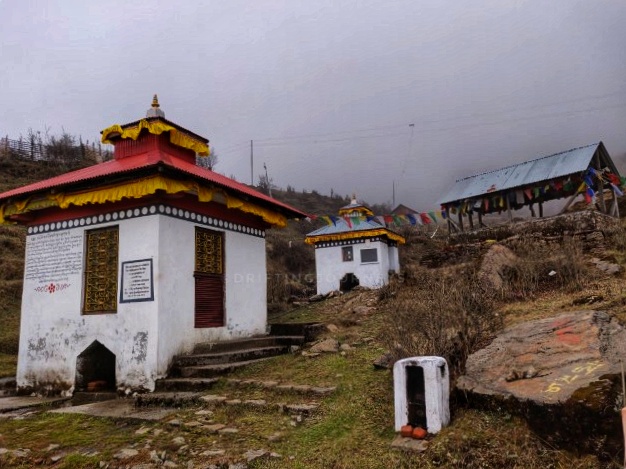
(Prayer wheels powered by water in local villages)

(First glimpse of Tumling village)
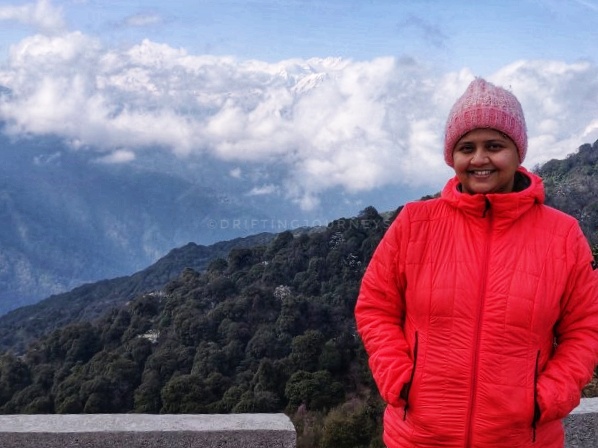
(Kanchenjunga playing peekaboo)
Day 3: Tumling to Kalapokhri (12 km – 7 hours)
Get ready for an exhilarating day as you step into Singalila National Park on Day 3 of your trek. Starting from Tumling, you’ll first encounter the check post where you’ll secure your permits and then dive into the adventure ahead.

(Rhododendron trees on the way)

(Crossing thick forest)
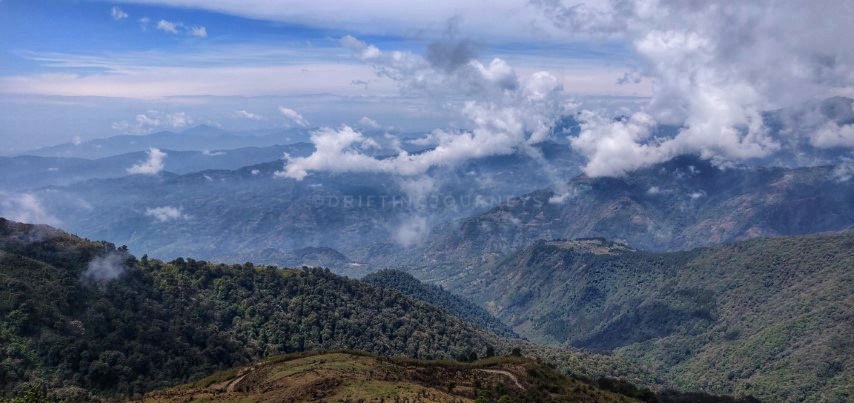
(The Nepal region)

(Gairibas from the top)

(Kalapokhri means dark pond and is named because the water of this pond is really dark and the locals worship this pond)
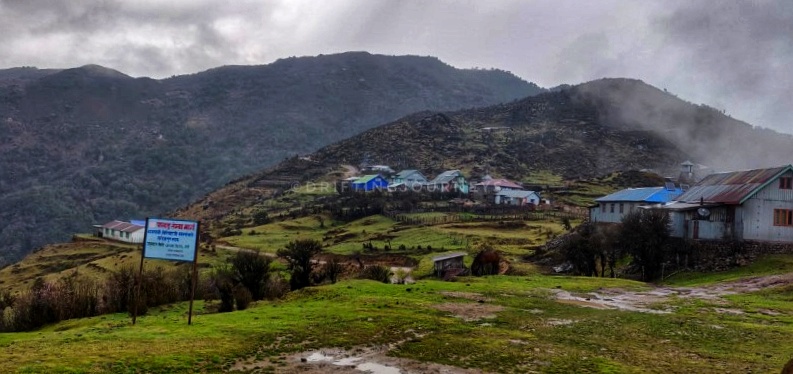
(Kalapokhri village)
Day 4: Kalapokhri to Sandakphu (6 km – 3/4 hours)
While today’s trek may cover the shortest distance, it certainly packs a punch with its challenging ascents. The path from Kalapokhri to Sandakphu is a demanding climb with steep, relentless inclines.



(The last steep climb of Sandakphu where you are made to take baby steps)
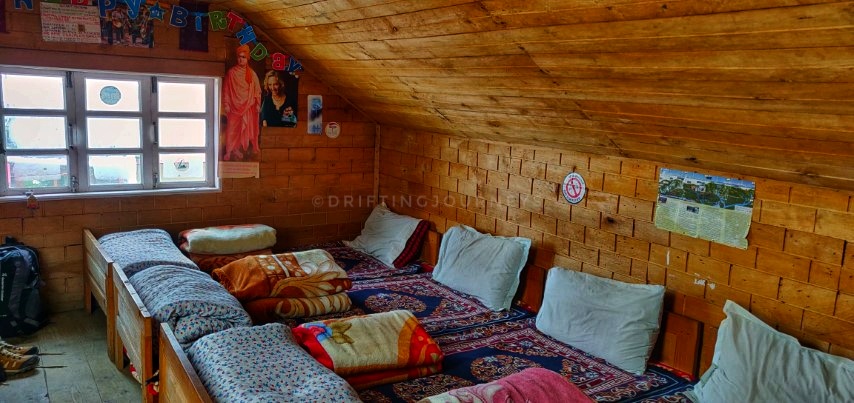


(Everest, Lhotse, and Makalu hiding behind the thick cloud cover)


(Pic courtesy: drifting_in_the_winds)
Day 5: Sandakphu to Timburey (15 km – 8 hours)
One of the highlights of the Sandakphu trek is the breathtaking sunrise.


(The trio peaking from the clouds)


Today’s trek is the longest of the entire journey, featuring a nearly continuous descent to the village of Timburey.


After about three hours, the trail reaches the edge of a ridge, revealing a vast, open valley that stretches endlessly before you. Take a moment to absorb this expansive view, which seems to go on forever.



(Srikhola village)
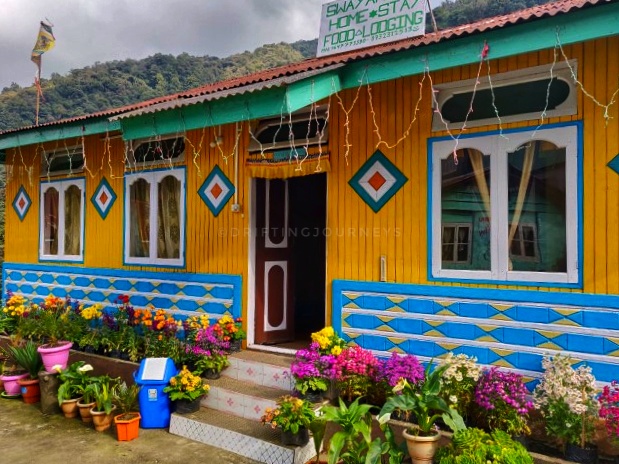
(Cozy homestay on the last day)

Day 6: Return to NJP/Bagdogra
The final day of your trek begins with a 2-hour descent from Timburey to Srikhola village. From there, you’ll catch a shared taxi for the journey back to Siliguri.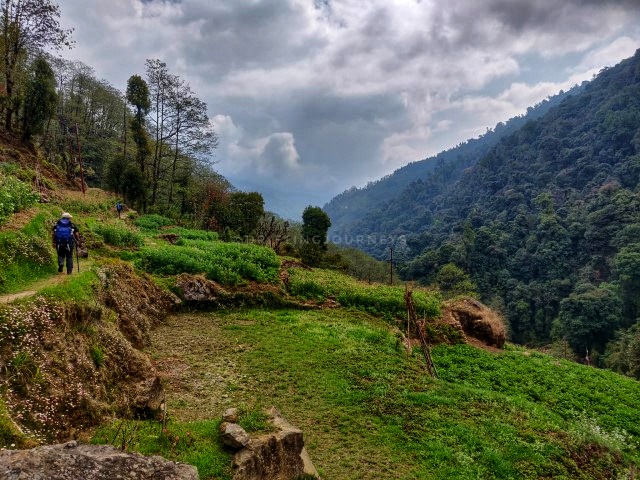

Key Highlights
Mountain Views
Sandakphu delivers breathtaking panoramic views of the world’s highest peaks. From the majestic Sleeping Buddha to the awe-inspiring Everest family, you’ll have countless opportunities to capture stunning photographs of these towering giants.
Village Life
Passing through quaint villages offers a glimpse into the local culture and lifestyle. The residents are often curious and welcoming, making it a wonderful chance to engage with them, hear their stories, and gain insights into their customs and traditions.Indo-Nepal Border
The trek crosses between India and Nepal, showcasing the close-knit relationship between the two cultures and landscapes. You might even notice your phone picking up Nepalese network signals from time to time!Rhododendron Blooms
If you’re trekking in the spring, the trail is adorned with vibrant rhododendron blooms. These colorful flowers add a stunning splash of color to the already spectacular scenery.
Packing and Preparation
Packing List
Refer to my detailed packing list on the blog for a comprehensive guide.
Pack light, but make sure you include all the essentials. Even for summer treks, bring warm layers as temperatures can drop significantly at night. Don’t forget rain gear to stay dry irrespective of the season as it may rain any time on the mountains, especially post noon. Pack enough snacks to keep your energy up during long hikes.
Fitness and Training
Preparation for the trek should start at least 4 months in advance. Focus on building endurance, strength, and lung capacity. Regular runs, strength training, and yoga will help you get in shape. Aim to be able to run 5 km in 40 minutes. This ensures you have the stamina for the trek.
Safety and Health
Medical Check
Get a general fitness check-up before your trek. Ensure you’re in good health to handle the physical demands of the trek.
Altitude Sickness
Though the risk is minimal, it’s always good to be prepared. Carry preventive medication if you’re prone to altitude sickness. Stay hydrated and take it easy to avoid symptoms.
First Aid
Carry a basic first aid kit with essentials like band-aids, antiseptic cream, painkillers, and any personal medications.
Sustainability and Responsible Trekking
Reusable Items
Use reusable bottles, containers, and utensils to minimize waste. Avoid single-use plastics and carry your trash back with you.
Leave No Trace
Respect the environment by leaving no trace. Stick to marked trails, don’t litter, and avoid disturbing wildlife.
Respect Local Customs
Learn and follow local customs and guidelines. Dress modestly and be polite to locals. Respect their culture and traditions.
Personal Experiences and Stories
- The Sandakphu trek, often labeled as a small and easy trek, taught me never to underestimate the mountains. Nature can be ruthless, and it requires both mental and physical resilience to face the challenges it presents.
- One of the biggest lessons I learned was how unpredictable mountain weather can be. On the third day, as we left Tumling for Kalapokhri, the weather was warm and sunny. We were sweating by the time we reached Gairibas for a momos break. However, within just 15 minutes of resuming our trek, the sky darkened, and a fierce wind picked up. The temperature plummeted, and within 10 minutes, we were hit by small pebbles of ice, which quickly escalated into a full-blown hailstorm. Despite our rain covers, we were pelted by ice, our hands and feet went numb, and we were drenched through. The temperature dropped to single digits, and wearing those wet shoes in the cold the next day was a tough challenge.
- As any seasoned mountain trekker knows, a breathtaking view often hinges on sheer luck. We were incredibly fortunate to witness a crystal-clear view of the Kanchenjunga massif. I still get goosebumps thinking about that magical morning when we stood above the clouds, marveling at nature’s grandeur.
- Our last evening in Timburey was equally enchanting. We relaxed by a nearby stream, taking numerous pictures and soaking in the serene ambiance. The sound of the flowing water, the cold weather, the carefree laughter, and the sense of accomplishment created a core memory I will cherish forever.
The Final Takeway
Sandakphu serves as an excellent introduction to trekking for beginners, but remember, fitness is key to fully enjoying the experience. You have the option to off-load your backpack (for an additional fee), allowing you to carry only the essentials and enjoy the climb with greater ease.
Keep in mind that mountain views can be unpredictable. Approach the trek with an open mind and leave room for surprises. Even if the weather doesn’t cooperate, embrace the journey, capture the moments, and create lasting memories.
I hope this blog inspires you to take your first step into the world of trekking. Are you excited to explore Sandakphu? If you’ve already been there, I’d love to hear about your experience—share it in the comments below!
For more travel tips and updates, follow me on Instagram.
Until next time!

